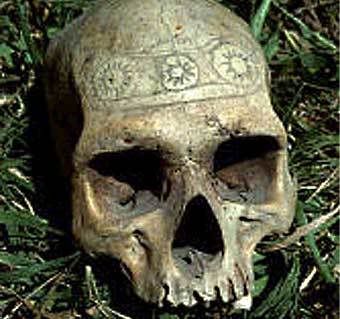deadman_932

Posts: 3094
Joined: May 2006
|
It's sort of interesting: I assume (perhaps mistakenly, given the ambiguity of how Mr. Hunter has been posting) that he's essentially asking HOW do we assign traits/characters into homology and homoplasy categories. Can we justify our assumptions there?
Keeping in mind that science doesn't deal in absolute,immutable truths and that such designations can be changed at any moment due to new discoveries ( because science is always tentative)...what seems to be the problem?
Well, here's the deal:
I would argue that what Mr. hunter is attempting to do --in his roundabout, ambiguity-laden way -- is to place ID and modern evolutionary theory on an "even playing field" by saying "both research programs are based on metaphysical and unfalsifiable assumptions."
The fact that he can't come out and say that is amusing to me.
In the past, prior to the genetic revolution and evo-devo studies, yep, there was a lot more seeming arbitrariness in placing things into "homology v. homoplasy" categories. But even a cursory scan of the relevant literature today has yielded me a bounty of information on the very topic...in just ten minutes, I gathered these papers:
Abouheif E. Developmental genetics and homology: a hierarchical approach. Trends Ecol Evol. 1997;12:405-408.
Abouheif E, Akam M, Dickinson WJ, Holland PWH, Meyer A, Patel NH, Raff RA, Roth VL, Wray GA. Homology and developmental genes. Trends Genet. 1997;13:432-433.
Arthur W. The concept of developmental reprogramming and the quest for an inclusive theory of evolutionary mechanisms. Evol Dev. 2000;2:49-57
Arthur W. Developmental drive: an important determinant of the direction of phenotypic evolution. Evol Dev. 2001;3:271-278
Arthur W. The emerging conceptual framework of evolutionary developmental biology. Nature. 2002;415:757-764
Brigandt, I. (2003) “Homology in comparative, molecular, and evolutionary developmental biology: The radiation of a concept.” Journal of Experimental Zoology (Molecular and Developmental Evolution) 299B: 9-17
Caroll S. Endless forms: the evolution of gene regulation and morphological diversity. Cell. 2000;101:577-580.
Carroll, SB.;Grenier, JK.; Weatherbee, SD. From DNA to Diversity: Molecular Genetics and the Evolution of Animal Design. Malden, MA: Blackwell Science; 2001. Shimeld SM, Holland
Carroll SB. Evolution at two levels: on genes and form. PLOS Biology. 2005;3:e245.
Davidson, EH. Genomic Regulatory Systems. Development and Evolution. San Diego: Academic Press; 2001.
Donoghue M, Ree RH. Homoplasy and developmental constraint: a model and an example from plants. Am Zool. 2000;40:759-769.
Fitch W. Homology - a personal view on some of the problems. Trends Genet. 2000;16:227-231.
Galliot B, Miller DJ. Origin of anterior patterning - how old is our head? Trends Genet. 2000;16:1-5.
Hedges SB. The origin and evolution of model organisms. Nat Rev Genet. 2002;3:838-849
Hedges SB, Blair JE, Venturi ML, Shoe JL. A molecular timescale of eukaryote evolution and the rise of complex multicellular life. BMC Evol Biol. 2004;4:2.
Hughes AL, Friedmann R. Shedding genomic ballast; extensive parallel loss of ancestral gene families in animals. J Mol Evol. 2004;59:827-833.
Jenner RA. Evolution of animal body plans: the role of metazoan phylogeny at the interface between patterns and processes. Evol Dev. 2000;2:208-221
Levine M, Tjian R. Transcription regulation and animal diversity. Nature. 2003;424:147-151
Meyer, A. Homology and homoplasy: the retention of genetic programs. In: Brock GR, Cardew G. , editor. Homology Symposium on Homology held at the Novartis Foundation (Symposium 222); London. Wiley: Chichester, UK; 1999. pp. 141-157.
Mindell DP, Meyer A. Homology evolving. Trends Ecol Evol. 2001;16:434-440.
Raff, RA. The Shape of Life: Genes, Development and the Evolution of Animal Form. Chicago: Chicago University Press; 1996.
Raible F, Arendt D. Metazoan evolution: some animals are more equal than others. Curr Biol. 2004;14:R106-108.
Telford MJ, Budd GE. The place of phylogeny and cladistics in Evo-Devo research. Int J Dev Biol. 2003;47:479-490.
True JR, Carroll SB. Gene co-option in physiological and morphological evolution. Annu Rev Cell Dev Biol. 2002;18:53-80.
Wake, DB. Homology and homoplasy. In: Edited by Hall BK, Olson WM. , editor. Keywords and Concepts in Evolutionary Developmental Biology. Harvard: Harvard University Press; 2003. pp. 190-201.
Wilkins, AS. The Evolution of Developmental Pathways. Sunderland: Sinauer Associates; 2002.
Wray GA, Abouheif E. When is homology not homology? Curr Opin Genet Dev. 1998;8:675-680.
Now, I have no particular interest in this area, but even I can see there's a lot of work being done there. Science is rarely satisfied by arbitrariness, and there seems to be a distinct trend in justifying how we categorize traits/characters.
Do we HAVE a specific algorithm NOW? No...but won't you join us and contribute to our search, Mr. Hunter?
Again, a mind is a terrible thing to waste at DI, which does little peer-reviewed research that I know of.
--------------
AtBC Award for Thoroughness in the Face of Creationism
|


















